Featured Articles
Martinez Can Go Home Again, But Maybe Not To Stay

All he knew was that the years flow by like water, and that one day men come home again.
—-Thomas Wolfe, “You Can’t Go Home Again”
Wolfe, the early 20th century American novelist, was just 37 when he died on Sept. 15, 1938, but his most-quoted work – published posthumously in 1940 – captures the essence of WBC middleweight champion Sergio “Maravilla” Martinez, who at once is irresistibly drawn to the country of his birth while at the same time reluctant to revisit old times and more than a few unpleasant memories. Men do tend to come home again, but often with as much apprehension as anticipation.
To the 45,000 or so Martinez-worshipping boxing fans who will jam into an outdoor soccer stadium in Buenos Aires, Argentina, on April 27 to witness their pugilistic hero’s first ring appearance in his homeland in 11 years – his opponent in the HBO-televised bout will be Englishman Martin Murray – Martinez’s internal conflict is of little consequence. Argentina has a proud history of producing excellent boxers (Carlos Monzon, Pascual Perez, Hugo Corro, Niccolino Loche, et al) and Martinez (50-2-2, 28 KOs) no doubt will enhance his status as one of its all-time greats should he handle Murray (25-0-1, 11 KOs) as he has his recent opponents.
How big is the 38-year-old Martinez (seen above, in Chris Farina-Top Rank photo, exulting after finishing fight vs. Julio Cesar Chavez Jr. last year) in the South American country of over 41 million residents? He was named Argentina’s most popular sports personality of 2012, edging out soccer superstar Lionel Messi. That’s fairly amazing, considering that soccer is Argentina’s foremost sporting obsession, as well as the fact that Martinez has spent more than a decade living abroad, in such jewels of European culture as Rome and Madrid, as well as Oxnard, Calif., although he has since relocated back to Spain.
“I don’t want to go back to where I came from,” he has said of his impoverished childhood and adolescence in Quilmes, Argentina, in Buenos Aires Province, which he has described as a “dirt-poor rural village.”
A naturally gifted athlete who was, at various times, a professional soccer player, professional cyclist and competitive tennis player, Martinez, a southpaw, didn’t even try his hand at boxing until the advanced age of 20. He compiled a 39-2 amateur record before turning pro, at 22, with a second-round disqualification victory over Cristian Marcelo Vivas. He was 16-0-1, all his bouts in Argentina, before his first scrap elsewhere, and his first in the United States, on Feb. 19, 2000, at the Mandalay Bay in Las Vegas. But that fight – part of the undercard of a show headlined by the first of three classic matchups of Marco Antonio Barrera and Erik Morales – ended badly for Martinez, who was stopped in seven rounds by Antonio Margarito.
A chastened Martinez returned to Argentina, where he won his next seven fights, before taking off to Madrid, where he hooked up with trainer Gabriel Sarmiento. Eleven of his next 14 bouts were in Spain (the other three were in the United Kingdom) before he was “discovered” in 2007 by American promoter Lou DiBella, who wondered how someone with that much talent could have flown beneath boxing’s global radar for so long.
“He’s the best pure athlete I’ve ever promoted,” DiBella gushed after Martinez captured the WBC and WBO 160-pound titles on a 12-round unanimous decision over Kelly Pavlik on April 17, 2010, in Atlantic City’s Boardwalk Hall. “When I first saw a tape of this guy I thought, `Where has he been? He can fight his rear end off.’
“I was sort of stunned that he was out there and available to me. I couldn’t believe somebody with Sergio’s talent hadn’t been picked up.”
The blood-splattered dethronement of the favored Pavlik – who was badly cut over his left eye and gashed even worse beneath the right one — was a sort of coming-out party for Martinez in America, even though it was his ninth consecutive fight on these shores, and the 10th overall. Maybe that was because he picked a good night to sparkle, flooring Pavlik with a short right hand in the eighth round, when he was behind on two of the three judges’ scorecards. It was all Martinez the rest of the way as he connected with, according to CompuBox, 34 of 63 power shots in the ninth round and outlanded Pavlik, 112 to 55, in rounds 9-12.
“I couldn’t see out of my right eye after he cut it (in Round 9),” Pavlik said at the postfight press conference. “He found the rhythm and smelled the blood.”
But it wasn’t until his next outing, also in Boardwalk Hall, that Martinez even more emphatically announced himself as one of the finest pound-for-pound fighters on the planet, starching Paul “The Punisher” Williams in the second round with a compact overhand left that more than made up for his disputed, majority-decision loss to Williams 11½ months earlier. The takeout shot packed so much power that Williams pitched forward onto the canvas, face first, not even attempting to break his fall. Referee Earl Morton didn’t bother with initiating the formality of a count.
“That punch would have knocked anyone on earth out,” DiBella said at the time. “I got the best fighter in the world. I ain’t trippin’. I don’t think either one of those guys (Floyd Mayweather Jr. and Manny Pacquiao) watched this fight and said, `I want to fight Sergio Martinez.’ I guarantee you that didn’t happen.”
Scan most of the top 10 P4P ratings compiled by knowledgable boxing observers and Martinez – the 2010 Fighter of the Year, as recognized by the Boxing Writers Association of America and The Ring –is generally in the third or fourth slot, behind only Mayweather, Andre Ward and, on some lists, Juan Manuel Marquez. He not only is properly acclaimed for his boxing skills and putaway power, but for his indomitable heart and tenacity (witness the way he fought his way out of deep trouble in the 12th round against Julio Cesar Chavez Jr., whom he had dominated over the first 11 rounds).
“His (left) hand was broken, he got knocked down, his (left) knee was messed up, but he got up and he didn’t look to hold,” DiBella told ESPN after Martinez’s tap-dance along the edge of disaster. “He looked to fight. Sergio Martinez is a man’s man. He could have held and grabbed Chavez, or just stayed away, but that is not who he is. He wanted to fight.”
But Martinez’s allure to the public is not restricted to his capabilities inside the ropes. He is a ruggedly handsome man, someone who at various times been described as “a sort of Marlboro man of the Pampas” and “a dark-haired Daniel Craig lookalike.” Craig is the movies’ latest James Bond.
It is not difficult to imagine Martinez on the silver screen as an Old West sheriff or Armani-clad dazzler. He has a cosmopolitan aura that hardly hints at his hardscrabble roots, and his wealth owes as much to prudent investments as to his purses from boxing. Perhaps not since Gene Tunney, the erudite two-time conqueror of Jack Dempsey, has boxing presented such a Renaissance man capable of slipping in and out of the conflicting worlds of elegance and violence.
“He’s an unusual athlete, an unusual fighter,” DiBella said in an interview with the New York Times. “He’s cerebral. Sensitive. Very artsy. Likes fashion. Has his own sense of style, which is extremely Euro. Great recall. He should be in Mensa, the way his mind works.”
All of which begs several questions: Why has Sergio Martinez, evolving worldwide icon but especially beloved in Argentina, only now decided to put himself on live display before the countrymen who so cherish him? Why hasn’t he opted to come home again after so long a self-imposed absence?
As it turns out, that cerebral, sensitive guy who can turn out your lights with a single punch was a child who knows that real robbery is something more terrifying than a couple of boxing judges submitting dubious scorecards. Martinez claims he was so victimized “at least 10 times” in his Argentine barrio while growing up, once by someone brandishing a lethal weapon. Thieves relieved him of, among other things, his watch (twice), shoes, wallet and bicycle. The loss of his fancy racing bike, at 15, prematurely ended his dream of becoming a world-class cyclist. His father, a construction worker, didn’t have the money to replace Sergio’s most prized possession.
“One day his computer school was closed,” Hugo Martinez, Sergio’s dad, said in the Times article. “Someone hit him with a gun in the eye. It was purple, bruised. We joked about his bad luck with robberies. It seemed like, if Sergio left the house, he got robbed.”
Encountering danger while on the street is hardly restricted to poor and disadvantaged citizens of a particular nation. Inner-city kids who have made it to boxing’s elite status understand that even the most glittering urban areas also have dark underbellies. There are always going to be those who have, and those who have not. It’s the have-nots who tend to gravitate toward boxing, where it is literally possible to fight your way to something better.
Aware of boxers who lost much of what they earned with their fists, Martinez is determined to hold onto the better way of life he has made for himself. He also knows that Murray, whose own background is specked with rough patches, will be coming at him with everything he has. Desperation – to get to the top, or to remain there — is the fuel that feeds every fighter’s inner fire.
“It doesn’t get any better for me than having the chance to prove myself against Martinez,” Murray said in the April edition of the UK’s Boxing Monthly. “As soon as we got offered the fight, I said, `Let’s (bleeping) do it.’ I jumped at it. He’s a great fighter, but not by any means unbeatable. I’ve got the style to beat him … I can out-think him and I can outfight him.”
DiBella, a former senior vice president of HBO Sports, has been around long enough to know it doesn’t pay to take anything for granted in the fight game. Murray, he notes, is a tough and legitimate 160-pounder while Martinez, if need be, can still make 154 with no problem. And then there is the self-imposed burden Martinez bears of feeling the need to deliver a spectacular homecoming performance. It is not unreasonable to believe there will be no more such returns.
“Sergio loves Argentina,” DiBella said. “I think he recognizes the problems that existed, the socio-economic issues that he had while growing up in poverty. But his homeland is his homeland, which is why I think this event is so important to him.
“There is going to be pressure on him. You can say it’s a purely happy situation, but walking into a stadium filled with adoring fans after so many years away, and as this huge celebrity, there has to be pressure. He’s a human being. But he’s also a consummate professional. I’m sure he’ll handle it. He has a lot to fight for.”
Murray also has more than mere boxing issues to contend with. Not only is he on Martinez’s turf, but he expects some residual resentment from the massive crowd over the fact he is English and many Argentines remember 1982’s Falklands Conflict, which pitted their country and the UK over a group of islands in the South Atlantic, east of Argentina. After 74 days of fighting, Argentina surrendered and the Falklands remained under British control, but past resentments sometimes die hard.
The 13-year age gap also is part of the storyline. For Martinez – an “overnight star” after battling his way up through the ranks for more than a decade – the challenge is to hold onto his hard-earned fame before his window of opportunity closes.
“He’s a young 38,” DiBella pointed out. “He’s certainly not old at 38. But I don’t think he’s a guy who’s going to keep going into his 40s. You’re probably looking at the last couple of active years of an exceptionally great athlete.”
So what might lie ahead in the stretch run?
“We’re not looking past Murray, but there are big fights out there for Sergio,” DiBella said. “Maybe the winner of (Matthew) Macklin and (Gennady) Golovkin. Other fighters are developing (as potentially lucrative opponents). And, obviously, the Chavez rematch is something that has to be considered.”
There is not a lot of data to suggest how Thomas Wolfe felt about boxing, or about boxers who leave home and return to high expectations. It will be interesting to see how this intriguing chapter in the big book of human drama unfolds.
Featured Articles
Bombs Away in Las Vegas where Inoue and Espinoza Scored Smashing Triumphs
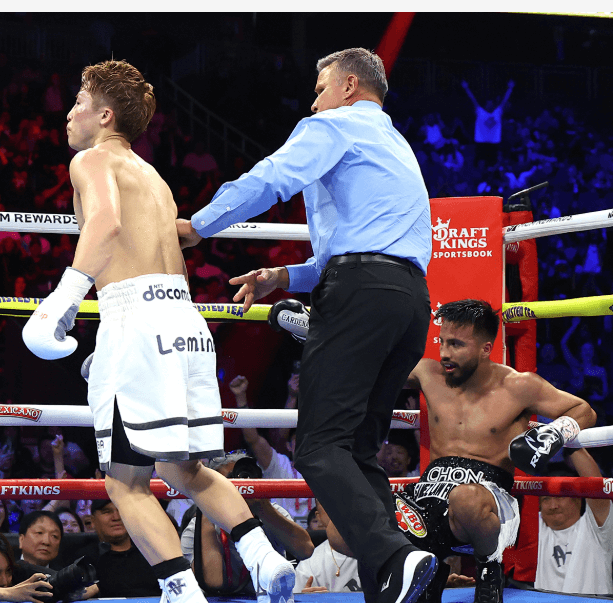
Japan’s Naoya “Monster” Inoue banged it out with Mexico’s Ramon Cardenas, survived an early knockdown and pounded out a stoppage win to retain the undisputed super bantamweight world championship on Sunday.
Japan and Mexico delivered for boxing fans again after American stars failed in back-to-back days.
“By watching tonight’s fight, everyone is well aware that I like to brawl,” Inoue said.
Inoue (30-0, 27 KOs), and Cardenas (26-2, 14 KOs) and his wicked left hook, showed the world and 8,474 fans at T-Mobile Arena in Las Vegas that prizefighting is about punching, not running.
After massive exposure for three days of fights that began in New York City, then moved to Riyadh, Saudi Arabia and then to Nevada, it was the casino capital of the world that delivered what most boxing fans appreciate- pure unadulterated action fights.
Monster Inoue immediately went to work as soon as the opening bell rang with a consistent attack on Cardenas, who very few people knew anything about.
One thing promised by Cardenas’ trainer Joel Diaz was that his fighter “can crack.”
Cardenas proved his trainer’s words truthful when he caught Inoue after a short violent exchange with a short left hook and down went the Japanese champion on his back. The crowd was shocked to its toes.
“I was very surprised,” said Inoue about getting dropped. ““In the first round, I felt I had good distance. It got loose in the second round. From then on, I made sure to not take that punch again.”
Inoue had no trouble getting up, but he did have trouble avoiding some of Cardenas massive blows delivered with evil intentions. Though Inoue did not go down again, a look of total astonishment blanketed his face.
A real fight was happening.
Cardenas, who resembles actor Andy Garcia, was never overly aggressive but kept that left hook of his cocked and ready to launch whenever he saw the moment. There were many moments against the hyper-aggressive Inoue.
Both fighters pack power and both looked to find the right moment. But after Inoue was knocked down by the left hook counter, he discovered a way to eliminate that weapon from Cardenas. Still, the Texas-based fighter had a strong right too.
In the sixth round Inoue opened up with one of his lightning combinations responsible for 10 consecutive knockout wins. Cardenas backed against the ropes and Inoue blasted away with blow after blow. Then suddenly, Cardenas turned Inoue around and had him on the ropes as the Mexican fighter unloaded nasty combinations to the body and head. Fans roared their approval.
“I dreamed about fighting in front of thousands of people in Las Vegas,” said Cardenas. “So, I came to give everything.”
Inoue looked a little surprised and had a slight Mona Lisa grin across his face. In the seventh round, the Japanese four-division world champion seemed ready to attack again full force and launched into the round guns blazing. Cardenas tried to catch Inoue again with counter left hooks but Inoue’s combos rained like deadly hail. Four consecutive rights by Inoue blasted Cardenas almost through the ropes. The referee Tom Taylor ruled it a knockdown. Cardenas beat the count and survived the round.
In the eighth round Inoue looked eager to attack and at the bell launched across the ring and unloaded more blows on Cardenas. A barrage of 14 unanswered blows forced the referee to stop the fight at 45 seconds of round eight for a technical knockout win.
“I knew he was tough,” said Inoue. “Boxing is not that easy.”
Espinoza Wins
WBO featherweight titlist Rafael Espinosa (27-0, 23 KOs) uppercut his way to a knockout win over Edward Vazquez (17-3, 4 KOs) in the seventh round.
“I wanted to fight a game fighter to show what I am capable,” said Espinoza.
Espinosa used the leverage of his six-foot, one-inch height to slice uppercuts under the guard of Vazquez. And when the tall Mexican from Guadalajara targeted the body, it was then that the Texas fighter began to wilt. But he never surrendered.
Though he connected against Espinoza in every round, he was not able to slow down the taller fighter and that allowed the Mexican fighter to unleash a 10-punch barrage including four consecutive uppercuts. The referee stopped the fight at 1:47 of the seventh round.
It was Espinoza’s third title defense.
Photo credit: Mikey Williams / Top Rank
To comment on this story in the Fight Forum CLICK HERE
Featured Articles
Undercard Results and Recaps from the Inoue-Cardenas Show in Las Vegas
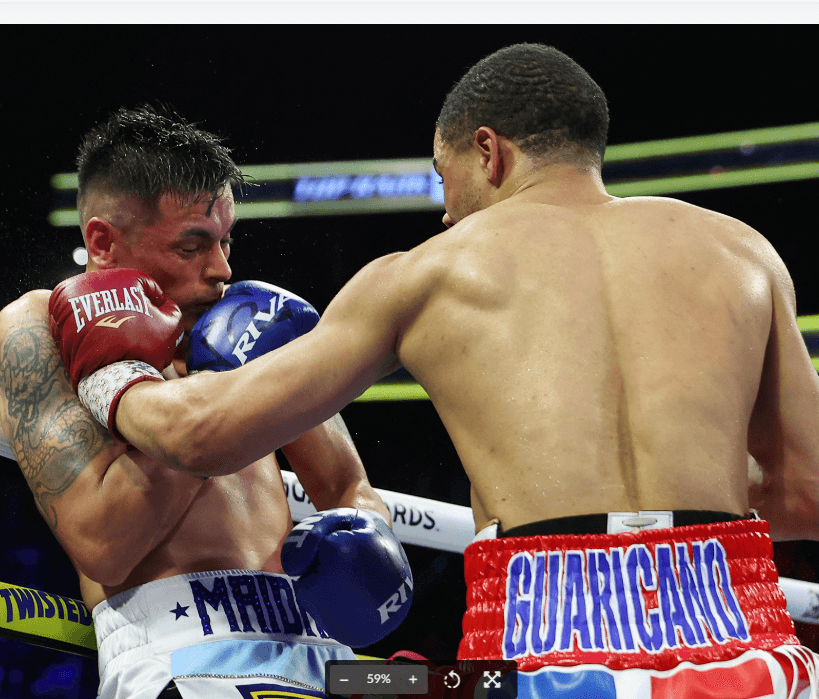
The curtain was drawn on a busy boxing weekend tonight at the T-Mobile Arena in Las Vegas where the featured attraction was Japanese superstar Naoya Inoue appearing in his twenty-fifth world title fight.
The top two fights (Inoue vs. Roman Cardenas for the unified 122-pound crown and Rafael Espinoza vs. Edward Vazquez for the WBO world featherweight diadem) aired on the main ESPN platform with the preliminaries streaming on ESPN+.
The finale of the preliminaries was a 10-rounder between welterweights Rohan Polanco and Fabian Maidana. A 2020/21 Olympian for the Dominican Republic, Polanco was a solid favorite and showed why by pitching a shutout, punctuating his triumph by knocking Maidana to his knees late in the final round with a hard punch to the pit of the stomach.
Polanco improved to 16-0 (10). Argentina’s Maidana, the younger brother of former world title-holder Marcos Maidana, fell to 24-4 while maintaining his distinction of never being stopped.
Emiliano Vargas, a rising force in the 140-pound division with the potential to become a crossover star, advanced to 14-0 (12 KOs) with a second-round stoppage Juan Leon. Vargas, who turned 21 last month, is the son of former U.S. Olympian Fernando Vargas who had big money fights with the likes of Felix Trinidad and Oscar De La Hoya. Emiliano knocked Leon down hard twice in round two – both the result of right-left combinations — before Robert Hoyle waived it off.
A 28-year-old Spaniard, Leon was 11-2-1 heading in.
In his U.S. debut, 29-year-old Japanese southpaw Mikito Nakano (13-0, 12 KOs) turned in an Inoue-like performance with a fourth-round stoppage of Puerto Rico’s Pedro Medina. Nakano, a featherweight, had Medina on the canvas five times before referee Harvey Dock waived it off at the 1:58 mark of round four. The shell-shocked Medina (16-2) came into the contest riding a 15-fight winning streak.
Lynwood, California junior middleweight Art Barrera Jr, a 19-year-old protégé of Robert Garcia, scored a sixth-round stoppage of Chicago’s Juan Carlos Guerra. There were no knockdowns, but the bout had turned sharply in Barrera’s favor when referee Thomas Taylor intervened. The official time was 1:15 of round six.
Barrera improved to 9-0 (7 KOs). The spunky but outclassed Guerra, who upset Nico Ali Walsh in his previous outing, declined to 6-2-1.
In the lid-lifter, a 10-round featherweight affair, Muskegon Michigan’s Ra’eese Aleem improved to 22-1 (12) with a unanimous decision over LA’s hard-trying Rudy Garcia (13-2-1). The judges had it 99-01, 98-92, and 97-93.
Aleem, 34, was making his second start since June of 2023 when he lost a split decision in Australia to Sam Goodman with a date with Naoya Inoue hanging in the balance.
Check back shortly for David Avila’s recaps of the two world title fights.
Photo credit: Mikey Williams / Top Rank
To comment on this story in the Fight Forum CLICK HERE
Featured Articles
Canelo Alvarez Upends Dancing Machine William Scull in Saudi Arabia
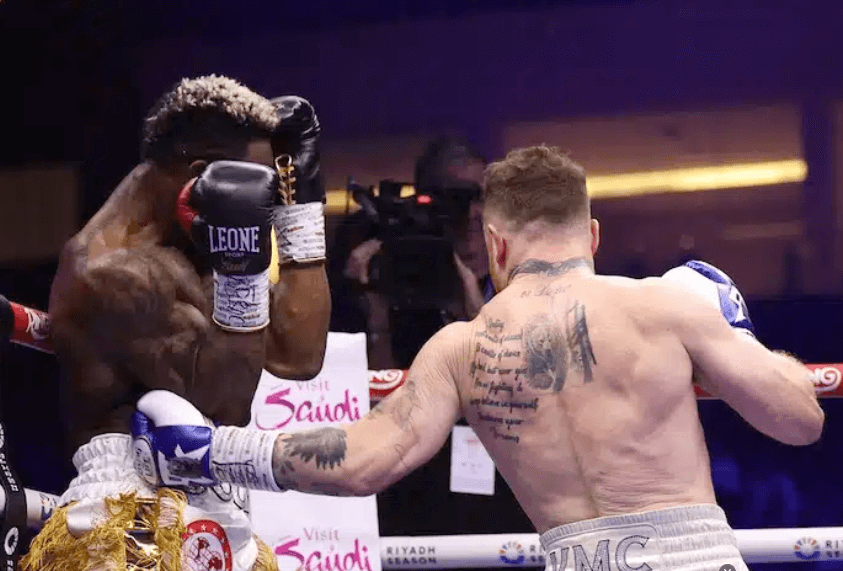
Saul “Canelo” Alvarez, who has acquired a new nickname – “The Face of Boxing” – is accustomed to fighting on Cinco De Mayo weekend, but this year was different. For the first time, Canelo was fighting outside the continent of North America and entering the ring at an awkward hour. His match with William Scull started at 6:30 on a Sunday morning in Riyadh.
In the opposite corner was 32-year-old William Scull, an undefeated (23-0) Cuban by way of Germany, whose performance was better suited to “Dancing With the Stars” than to a world title fight. Constantly bouncing from side to side but rarely letting his hands go, Scull frustrated Canelo who found it near-impossible to corner him, but one can’t win a fight solely on defense and the Mexican superstar was returned the rightful winner in a bout that was a fitting cap to a desultory two days of Saudi-promoted prizefighting. The scores were 115-113, 116-112, and 119-109. In winning, Canelo became a fully unified super middleweight champion twice over.
Terence Crawford was in attendance and HE Turki Alalshikh made it official: Crawford (41-0, 31 KOs) and Canelo (63-2-2, 39 KOs) will meet in the Fight of the Century (Alalshikh’s words) on Sept. 12 in Las Vegas at the home of the city’s NFL team, the Raiders. For whatever it’s worth, each of Canelo’s last seven fights has gone the full 12 rounds.
Semi-wind-up
In a match between the WBC world cruiserweight title-holder and the WBC world cruiserweight “champion in recess” (don’t ask), the former, Badou Jack, brought some clarity to the diadem by winning a narrow decision over Noel Mikaelian. One of the judges had it a draw (114-114), but the others gave the fight to “Jack the Ripper” by 115-113 scores.
A devout Muslim who is now a full-time resident of Saudi Arabia, the Sweden-born Jack, a three-division title-holder, had the crowd in his corner. Now 41 years old, he advanced his record to 29-3-3 (17). It was the first pro loss for Mikaelian (27-1), a Florida-based Armenian who was subbing for Ryan Rozicki.
The distracted CompuBox operator credited Mikaelian with throwing 300 more punches but there was no controversy.
Tijuana’s Jaime Munguia, a former junior middleweight title-holder, avenged his shocking loss to Bruno Sarace with a unanimous 12-round decision in their rematch. This was Munguia’s first fight with Eddy Reynoso in his corner. The scores were 117-111 and 116-112 twice.
Surace’s one-punch knockout of Munguia in mid-December in Tijuana was the runaway pick for the 2024 Upset of the Year. Heading in, Munguia was 44-1 with his lone defeat coming at the hands of Canelo Alvarez. Munguia had won every round against Surace before the roof fell in on him.
Surace won a few rounds tonight, but Munguia was the busier fighter and landed the cleaner shots. It was the first pro loss for Surace (26-1-2) and ended his 23-fight winning streak. The Frenchman hails for Marseilles.
Heavyweights
In a 10-round heavyweight match fought at a glacial pace, Martin Bakole (21-2-1) and Efe Ajagba (20-1-1) fought to a draw. One of the judges favored Ajagba 96-94 but he was outvoted by his cohorts who each had it 95-95.
Bakole, a 7/2 favorite, came in at 299 pounds, 15 more than he carried in his signature win over Jared Anderson, and looked sluggish. He was never able to effectively close off the ring against the elusive Ajagba who fought off his back foot and failed to build on his early lead.
The fight between the Scotch-Congolese campaigner Bakole and his Nigerian-American foe was informally contested for the heavyweight championship of Africa. That “title” remains vacant.
In a 6-rounder, heavy-handed Cuban light heavyweight Brayon Leon, a stablemate of Canelo Alvarez, was extended the distance for the first time while advancing his record to 7-0 at the expense of Mexico’s Aaron Roche (11-4-1). Leon knocked Roche to the canvas in the fourth round with a right-left combination, but the Mexican stayed the course while eating a lot of hard punches.
Photo credit: Leigh Dawney / Queensberry Promotions
To comment on this story in the Fight Forum CLICK HERE
-
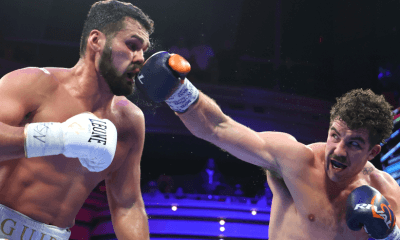
 Featured Articles4 weeks ago
Featured Articles4 weeks agoResults and Recaps from Las Vegas where Richard Torrez Jr Mauled Guido Vianello
-
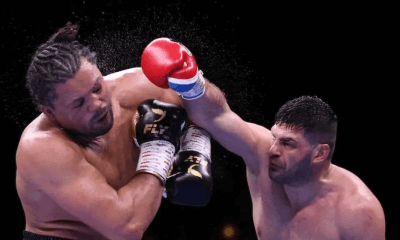
 Featured Articles4 weeks ago
Featured Articles4 weeks agoWeekend Recap and More with the Accent of Heavyweights
-
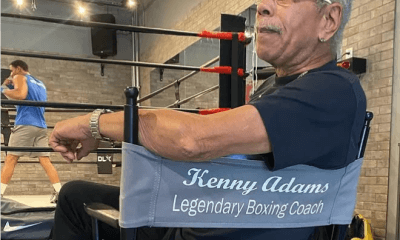
 Featured Articles4 weeks ago
Featured Articles4 weeks agoRemembering Hall of Fame Boxing Trainer Kenny Adams
-
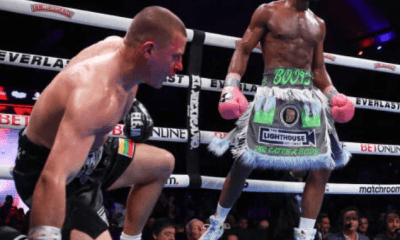
 Featured Articles3 weeks ago
Featured Articles3 weeks agoJaron ‘Boots’ Ennis Wins Welterweight Showdown in Atlantic City
-

 Featured Articles3 weeks ago
Featured Articles3 weeks agoBoxing Notes and Nuggets from Thomas Hauser
-
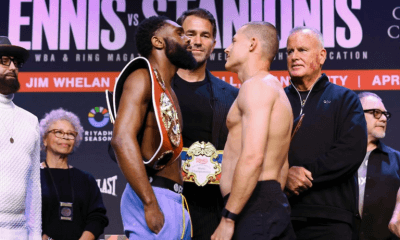
 Featured Articles3 weeks ago
Featured Articles3 weeks agoAvila Perspective Chap 320: Boots Ennis and Stanionis
-
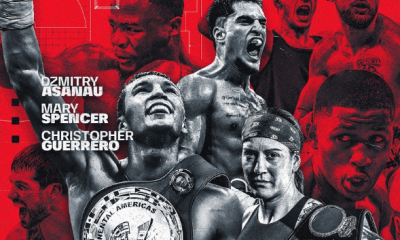
 Featured Articles4 weeks ago
Featured Articles4 weeks agoDzmitry Asanau Flummoxes Francesco Patera on a Ho-Hum Card in Montreal
-
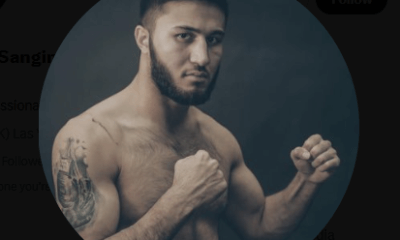
 Featured Articles3 weeks ago
Featured Articles3 weeks agoMekhrubon Sanginov, whose Heroism Nearly Proved Fatal, Returns on Saturday















